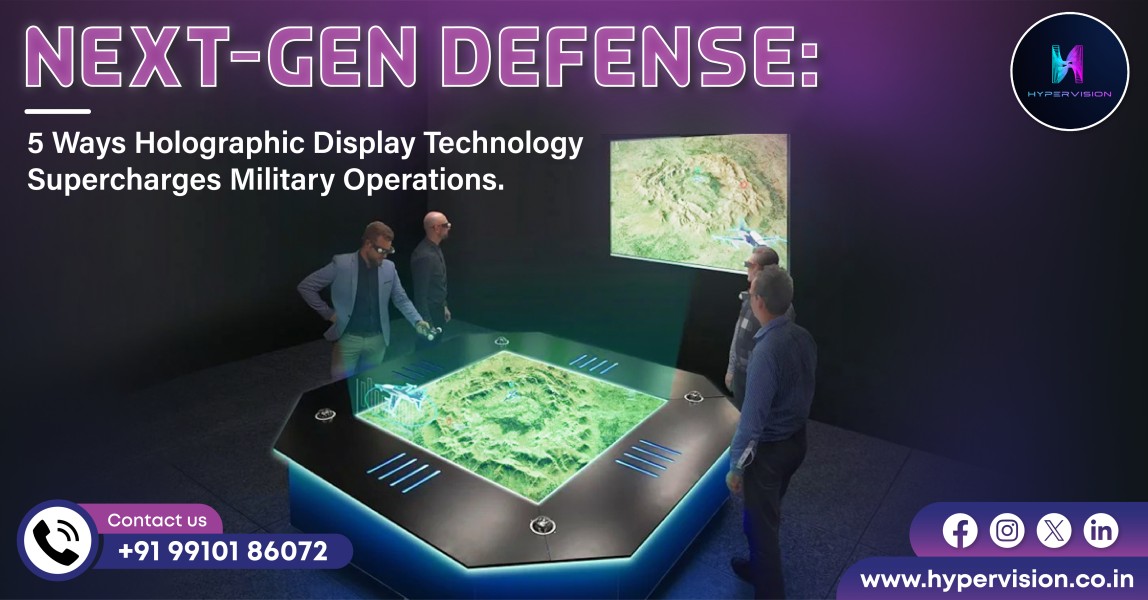Innovation is essential to determining the future of defense operations in the quickly changing field of military technology. Military strategists are particularly interested in the revolutionary development of holographic display technology. Leading this change is HyperVision, which is enhancing military operations with 3D holograms, lidar scanners, and holographic projection.
We will look at five major ways that holographic display technology is changing the landscape of next-generation defense in this blog.
Improved Contextual Awareness : On the battlefield, holographic displays are essential for improving situational awareness.
The Holographic Display from Hypervision provides soldiers a perspective of the battlefield that is unmatched. A lidar scanner and HyperVision's holographic display technology make sure that the augmented data blends in perfectly with the surrounding surroundings. Holographic situational awareness gives you the ability to see past walls, maneuver through dangerous terrain with ease, and predict opponent movements.
Planning a mission and accurate targeting: For the purpose of limiting collateral damage and guaranteeing mission success, accurate targeting is essential. Commanders now have a new way to organize and visualize missions in three dimensions: holographic screens.
Through the use of holographic depictions of the battlefield, soldiers can engage in various engagement scenarios, launch virtual forces, and identify targets with extreme precision.
Improved Cooperation and Communication: In a combat zone, a breakdown in communication can have catastrophic consequences. Effective communication is critical in the military. Soldiers may exchange vital information, give orders, and plan actions in real time without having to worry about enemy eavesdropping when they use holographic communication.
No matter where units are physically located, holographic display technology enables improved communication and collaboration among them. Commanders may view and plan in real-time via holographic projections, which facilitates quicker decision-making. Military leaders may communicate 3D holographic models of topography, mission goals, and tactical plans thanks to HyperVision's cutting-edge holographic projection technologies, which encourage a more coordinated and integrated approach to operations.
Advanced Training and Simulations: Soldiers must receive quality training in order to be prepared for the reality of combat. Conventional training techniques frequently lack realism and are unable to accurately simulate the confusion and stress of combat.
With the use of Hypervision's holographic simulations, soldiers can train in an incredibly realistic setting while facing hypothetical dangers, practicing tactical maneuvers, and refining their decision-making abilities. These realistic scenarios offer soldiers priceless experience that boosts their self-assurance and gets them ready for any eventuality in the real world.
Psychological Warfare and Deception: The use of holographic projection technology in military operations creates new avenues for strategic deception and misdirection.
Thanks to its creative methodology, HyperVision is able to produce holographic decoys and illusions that can fool and distract foes. There are difficulties in incorporating holographic display technology into military operations. It is necessary to address concerns regarding costs, data security, and ethical factors. Nonetheless, there is no denying this technology's prospective advantages. Hypervision is set to bring in a new era of next-generation military with its 3D holographic displays, which will alter the way our armed forces operate by boosting communication, enhancing situational awareness, and offering unmatched training opportunities.
In conclusion,
It's becoming more and more clear how HyperVision's advancements in holographic display technology will affect military operations. The combination of lidar scanners, holographic projection, and 3D holograms is bringing in a new era of next-generation defense. The applications are numerous and profound, ranging from deliberate deception to realistic training simulations.





Comments